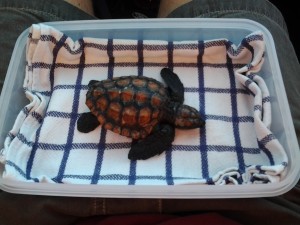 This past Friday I walked to the beach for a short run and yoga session when a surfer walked up and handed me a Loggerhead hatchling, an incredibly small turtle.
This past Friday I walked to the beach for a short run and yoga session when a surfer walked up and handed me a Loggerhead hatchling, an incredibly small turtle.
I took him back to my apartment complex and knocked on my neighbour Hannah’s door. The look on her face was priceless when she said good morning, but then saw the turtle cupped in my hands.
It was 7:30 am. Hannah called the Two Oceans Aquarium which instructed us how to care for him (her?) until we could make it to town. We placed her on a dry towel inside a small tupperware container and drove to Town. The turtle become more and more listless, eventually not moving unless I touched his shell or front flippers. Even then, almost no reaction. I was afraid she was not going to make it.
Kevin, a marine biologist greeted me at the front counter. I was given a behind-the-scenes tour as we worked our way up a few flights of stairs to a room full of noisy compressors, filtration systems, and glass aquariums which contained a variety of rescued sea animals. One was a very large turtle which was blind in both eyes, but is apparently recovering.
Kevin washed the hatchling in fresh water, removed a barnacle, and then placed her in a deep plastic tray at the bottom of what will be his new home for the coming year. He filled up the tank with room temperature water which in turn heated his container.
Kevin explained that Loggerheads do not nest on this side of the continent, so far south for the water is far too cold. He was likely caught in the Indian ocean current that periodically warms False Bay (and Muizenberg beach). He was adrift for no less than two weeks. Only one in a thousand reach sexual maturity (17-33 years), and even then, they have very low reproductive rates.
Within just a few minutes, the turtle came back to life. I had forgotten how much reptiles are affected by the temperature of their surroundings. The cold Atlantic water and then dry, cool air in the car had slowed her down considerably.
